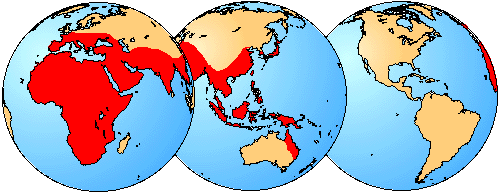Rhinolophidae
Horseshoe Bats
Nancy B. Simmons and Tenley Conway- Rhinolophinae
- Hipposiderinae
Introduction
Rhinolophidae is a family of carnivorous and insectivorous bats known from the Old World. The family is divided into two clades, Rhinolophinae and Hipposiderinae. Rhinolophinae currently includes 1 genus and over 60 species (Koopman, 1993). Hipposiderinae is a somewhat more diverse group that includes 9 genera and over 70 extant species (Koopman, 1993).
Characteristics
All rhinolophids share the following characteristics:- Presence of a well-developed noseleaf.
- Absence of a tragus.
- Modifications of the hyoid apperatus, including m. stylohyoideus with a slip that passes deep to digastic muscles, reduction of the ceratohyal to half the length of epihyal, and a large, flat expansion or "foot" on lateral cranial tip of the stylohyal.
- Modifications of the ribcage, including fusion of at least the first five anterior ribs to the vertebrae, fusion of the second rib to the sternum, costal cartilages absent or ossified, and ribs that lack anterior laminae.
- Absence of m. omocervicalis absent.
- Dorsomedial edge of the ascending process of the ilium upturned, flares dorsally above the level of iliosacral articulation, iliac fossa large and well-defined.
- Articulation between pubes in male restricted to small area, consists of an ossified interpubic ligament or short symphysis.
- Obtuator foramen patially infilled with thin, bony sheet along posteroventral rim.
- Gall bladder located in umbilical fissue of liver.
Discussion of Phylogenetic Relationships
Many authors recognize Rhinolophinae and Hipposiderinae as separate families, but there is overwhelming evidence that these groups are sister taxa (e.g., Pierson, 1986; Simmons, 1998; Simmons and Geisler, 1998; Kirsch et al., in press). Simmons (1998) and Simmons and Geisler (1998) followed Koopman (1993, 1994) in recognizing Hipposiderinae as a subfamily of Rhinolophidae, a nomenclatural arrangement that provides recognition of both the similarities and differences between these clades. Hipposiderine monophyly is strongly supported by morphological data (Simmons, 1998; Bogdanowicz and Owen, 1998; Hand and Kirsch, 1998) and monophyly of Rhinolophinae is supported by morphology (Bogdanowicz and Owen, 1992; Simmons, 1998) and immunological data (Pierson, 1986).
References
Bogdanowicz, W., and R. D. Owen. 1992. Phylogenetic analyses of the bat family Rhinolophidae. Zeitschrift für zoologische Systematik und Evolutionsforschung, 30:142-160.
Bogdanowicz, W., and R. D. Owen. 1998. In the Minotaur's labyrinth: the phylogeny of the bat family Hipposideridae. In Bats: Phylogeny, Morphology, Echolocation, and Conservation Biology. T. H. Kunz and P. A. Racey (eds.). Washington, D.C.: Smithsonian Institution Press.
Hand, S. J. and J. A. W. Kirsch. 1998. A southern origin for the Hipposideridae (Microchiroptera)? Evidence from the Australian fossil record. In Bats: Phylogeny, Morphology, Echolocation, and Conservation Biology. T. H. Kunz and P. A. Racey (eds.). Washington, D.C.: Smithsonian Institution Press.
Hill, J.E., and J.D. Smith. 1984. Bats: a natural history. Austin: University of Texas Press.
Koopman, K. F. 1983. Order Chiroptera. In Mammal species of the world, a taxonomic and geographic reference, 2nd ed. D. E. Wilson and D. M. Reeder. Washinton, D. C.: Smithsonian Institution Press.
Koopman, K. F. 1984. Chiroptera: systematics. Handbook of zoology, vol 8, pt. 60. Mammalia, 217 pp.
Pierson, E. D. 1986. Molecular systematics of the Microchiroptera: higher taxon relationships and biogeography. Ph.D. dissertation. University of California, Berkely, California.
Simmons, N. B. 1998. A reappraisal of interfamilial relationships of bats. In Bats: Phylogeny, Morphology, Echolocation and Conservation Biology. T.H. Kunz and P.A. Racey (eds.). Washington, D.C.: Smithsonian Institution Press.
Simmons, N. B. & J. H. Geisler. 1998. Phylogenetic relationships of Icaronycteris, Archeonycteris, Hassianycteris, and Palaeochiropteryx to extant bat lineages, with comments on the evolution of echolocation and foraging strategies in microchiroptera. Bulletin of the American Museum of Natural History. 235:1-182.
About This Page
Nancy B. Simmons

American Musuem of Natural History, New York, New York, USA
Tenley Conway

University of Toronto at Mississauga, Ontario, Canada
Correspondence regarding this page should be directed to Nancy B. Simmons at
Page copyright © 1997 Nancy B. Simmons
 Page: Tree of Life
Rhinolophidae. Horseshoe Bats.
Authored by
Nancy B. Simmons and Tenley Conway.
The TEXT of this page is licensed under the
Creative Commons Attribution License - Version 3.0. Note that images and other media
featured on this page are each governed by their own license, and they may or may not be available
for reuse. Click on an image or a media link to access the media data window, which provides the
relevant licensing information. For the general terms and conditions of ToL material reuse and
redistribution, please see the Tree of Life Copyright
Policies.
Page: Tree of Life
Rhinolophidae. Horseshoe Bats.
Authored by
Nancy B. Simmons and Tenley Conway.
The TEXT of this page is licensed under the
Creative Commons Attribution License - Version 3.0. Note that images and other media
featured on this page are each governed by their own license, and they may or may not be available
for reuse. Click on an image or a media link to access the media data window, which provides the
relevant licensing information. For the general terms and conditions of ToL material reuse and
redistribution, please see the Tree of Life Copyright
Policies.
Citing this page:
Simmons, Nancy B. and Tenley Conway. 1997. Rhinolophidae. Horseshoe Bats. Version 01 January 1997 (under construction). http://tolweb.org/Rhinolophidae/16126/1997.01.01 in The Tree of Life Web Project, http://tolweb.org/








 Go to quick links
Go to quick search
Go to navigation for this section of the ToL site
Go to detailed links for the ToL site
Go to quick links
Go to quick search
Go to navigation for this section of the ToL site
Go to detailed links for the ToL site